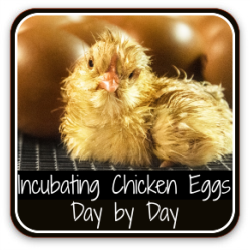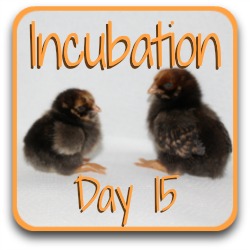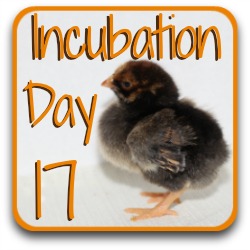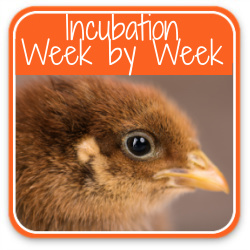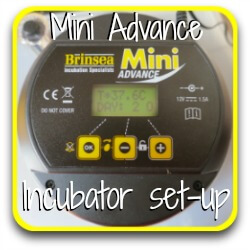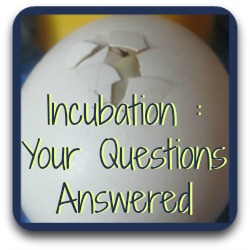- Home
- Incubation day by day
- Day 16
Incubation for chicks: what's happening at day 16?
Two days away from lockdown, about five from hatch. What's happening to the chick today, what should we be doing and what can go wrong?
We're now able to see less and less inside the egg, since the chick is now almost filling it. But there are still developments going on that we cannot see, even when candling.
Today and tomorrow (days 16 and 17), it's still important that temperature and humidity are kept consistent in the incubator, and that the eggs continue to be turned at intervals.
If you're not sure about the chicken egg incubation temperature and humidity levels, follow this link.

Incubation for chicks: what's happening in the egg today?
- We're just a few days from hatching now, and our chick is growing fast. There's very little room in the egg – it's taken up almost completely by the chick and the yolk.
- If we opened the egg at this point in incubation the chick would be lying alongside the yolk.
- The yolk is now much smaller. It's being slowly absorbed into the chick's body and will provide nutrition for the chick after it hatches.
What's happening to the chick at day 16 in the incubator?
- The chick is now well developed and recognisable. If we could see inside the egg we would be easily able to observe the beak, wings and legs.
- These bony structures continue to harden, using calcium taken from the shell.
- The down is now almost completely covering the chick, although it is wet rather than fluffy until the chick has not only hatched but dried out.
- The chick's intestines continue to be drawn into its body. The yolk is now becoming more important in terms of providing nutrients throughout the rest of incubation. It will continue to do so until about 48 hours after hatch.
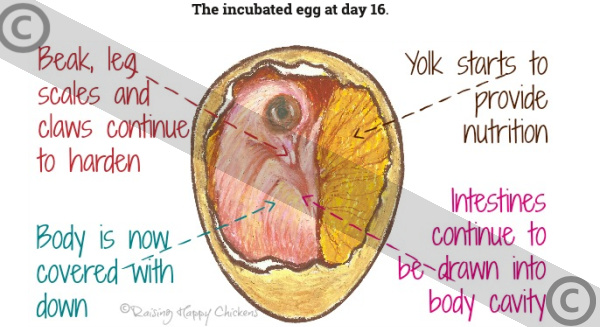
- The chick is now starting to prepare for hatch in a number of ways.
- As the chick loses moisture through the shell, it's replaced by air. So the air cell is now growing larger at the blunt end of the egg.
- Some chicks (but by no means all) begin slowly to turn their position in the egg so that they move towards the best place for hatching.
- This involves turning the head towards the blunt end. It's here the beak will 'pip' through into the internal membrane, and then through the shell.
What can we see if we candle the egg at this stage of incubation for chicks?
I don't recommend candling eggs at this late stage of incubation. The egg is now very porous and it's too easy for bacteria to enter, which is fatal for the chick.
We will be candling all our eggs anyway at day 18, before we lock down the incubator. There is really no reason to candle today.
If you decide to, please be scrupulous about hygiene.
Make sure when candling incubated chicken eggs that you observe strict hygiene processes. Eggs become porous during incubation, and bacteria are easily transmitted through the shell.
- Use a good quality, medicated hand sanitiser. (This is an affiliate link which means that if you click the link and buy a product, I earn a small commission).
- Ensure all surfaces, including the candler, are kept spotlessly clean.
The chick is now filling so much of the egg that it's almost as easy to see inside by candling in a room with a light on, which is how the photograph below was taken.
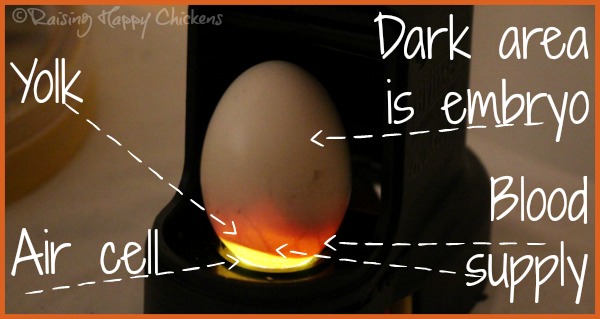
The chick is the dark area covering progressively more space. The blood vessels are clearly visible underneath, and the air cell is much bigger than it has been previously.
Below is a photograph taken in a darkened room. We can see more or less exactly the same features here, although the large blood vessels are more obvious.
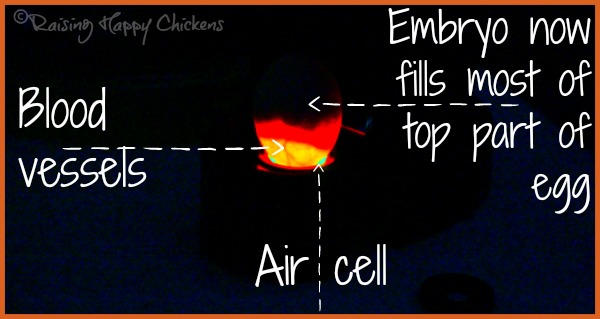
If candling today, you may be able to see movement in the lower area as the chick begins to prepare its position for hatch.
But it's not always obvious, so don't worry if you candle now and can't see it.
From now on, the growth of the darkened area and of the air cell is the best indicator that the chick is still developing.
Is there anything we should we be doing at day 16 of incubation?
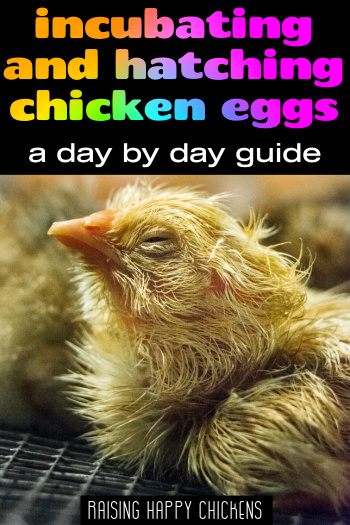 Pin Me!
Pin Me!No.
It's critically important now that the chick is left relatively undisturbed as it starts to position itself within the egg.
The eggs should still be turned until day 18, and temperature and humidity should be monitored and kept constant.
Make sure ventilation in the incubator is good to prevent the humidity levels rising too soon.
If you're incubating in the Brinsea Mini Advance (or any other of Brinsea's small incubators) this is taken care of for you.
In other incubators you may need to open the vent, allowing more air into the incubator.
Question of the day.
The humidity in my incubator is too high - how can I reduce it?
This depends entirely on the model of incubator. On many, there is a a slider which will open the vent, allowing more air into the incubator.
You will need to experiment with this in different hatches and with different incubators. If there is a vent, start by opening it and watching the digital readout on the lid.
If it falls too low, close the vent a little and wait for it to stabilise before altering it again, if necessary.
Below is my old Brinsea Octagon 20 incubator, which does have a slider. This model of incubator is now out of production, but you will find a similar setup on other brands.
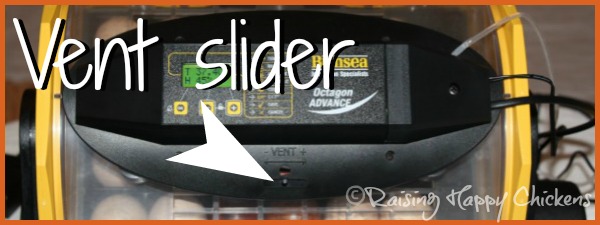
Allowing more air into the incubator reduces humidity, so raising the incubator lid can also bring the level down. However, that will also reduce the temperature, so it's not the way to fix the humidity levels if they're constantly rising.
Where would you like to go now?
To return to the very start of this series of incubation for chicks, use the first of these button links. The second will take you back to yesterday's information should you need a refresher, and the third will take you forward to tomorrow – day 17.
More related pages you may find helpful.
Sources.
A lot of "facts" you'll find on the internet are often people's individual views, based on inaccurate information repeated from poor quality sources.
The information I provide in this article and others is based on both my own experience of incubating and hatching chicken eggs every year for over 13 years, but on evidenced facts from scientific, peer-reviewed research and books from highly respected and experienced poultry keepers such as Gail Damerow.
Some of the trusted sources I have used in this article are these.
Avitronics: Heart Rates. Pub. Avian ID, 2020.
Damerow, Gail: Hatching and Brooding Your Own Chicks. Pub. Storey, 2013. See my review, here.
Hall, C., et al: A new candling procedure for thick and opaque eggs and its application to avian conservation management. Pub. Journal of Zoobiology, 2022.
Hamburger, V and Hamilton, H L: A series of normal stages in the development of the chick embryo. Pub. Journal of Morphology, 1951.
Leonor, H., and Chaveiro, S: The Effect of Candling on the Hatchability of Eggs from Broiler Breeder Hens. Pub. Journal of Applied Poultry Research, 1993.
Phuphanin, A., et al: Smartphone-Based Device for Non-Invasive Heart-Rate Measurement of Chicken Embryos. Pub. National Center for Biotechnology Information, 2019.
Vargas, R., et al: Egg Candling Analysis Equipment Design: A Safety Solution. Pub. Journal of Social and Behavioural Sciences, 2018.
Wu et al: Egg fertility and reduced egg fertility, hatching success, and larval survival. Pub. Science Direct, 2003.
- Home
- Incubation day by day
- Day 16
